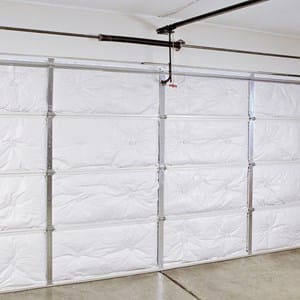Depending on where you live, the temperature in your garage can be unbearable. It can easily fall to below freezing in winter months, while summers in the south can push the temperatures over 100 degrees.
I recommend starting with the largest non-insulated surface in your home: your garage door.
Insulation won’t make your garage warm and toasty by itself.
However, adding a garage door insulation kit is one of the most effective (and inexpensive) ways to get a few more months of comfortable use out of your garage.
I’ve compiled a list of the three best garage door insulation kits available today. You’ll also find a quick guide on the different types of insulation and which ones make sense for your garage.
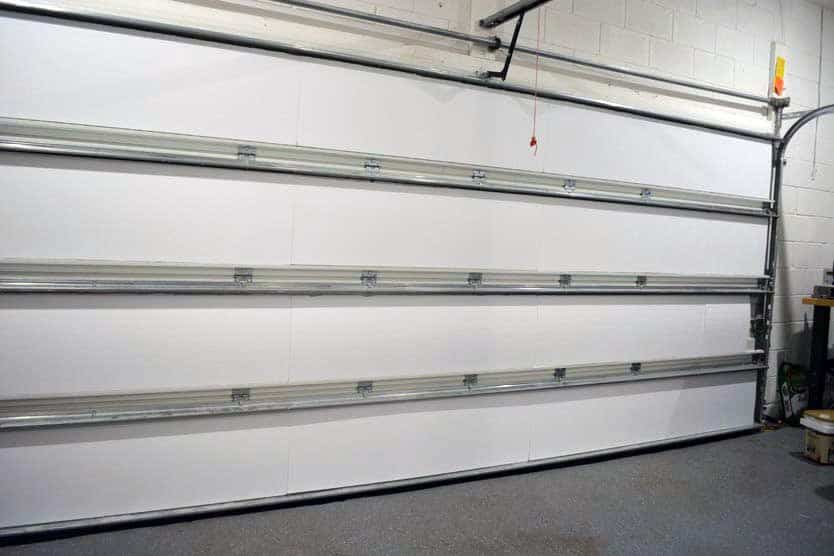
Why Should You Insulate Your Garage Door?
Your garage door is the single biggest non-insulated surface in our home. That means there’s nothing but a thin layer of metal between your home and the outside.
If you have an attached garage and think a thin metal door is enough, I want you to try something.
Go out to your garage in the middle of a hot summer day or a cold day in the winter. Then…place your bare hand on the door.
Ouch.
Adding just a tiny amount of insulation can make a big difference in the inside temperature.
You can add insulation to both new and existing garage doors. Garage door insulation kits made of foam or reflective barriers can easily be added to existing doors. These kits usually have an R-value of between R-2 and R-8. Alternatively, most garage door manufacturers sell brand new insulated garage doors for even better results. New insulated garage doors have R-values from R-6 to R-19.
Combined with weatherstripping and insulating other areas of your garage, insulating your garage door could stop heat loss and increase the inside temperature of your garage by 10 to 12 degrees in the winter.
This will, in effect, address the “weakest link” of the insulation process (your garage door), improving your garage’s indoor temperature overall.
Benefits of Garage Door Insulation
As I mentioned above, an insulated garage door will keep your indoor garage space warmer in the winter and cooler in the summer.
However, these are far from the only benefits. You will also effectively:
- Energy Savings: If you live in a warmer climate, this might not be a factor as much as it would in the northern states. However, you can generally save around 12% on your total energy costs by installing insulation to your garage door.
- Increase Your Property Value: Since garage door insulation will save you money in energy costs, it can also increase your overall property value. According to a Remodeling Value Report issued in 2019, you would recoup some 95.2% of your investment when selling your home. (East North Central Region of America numbers). Again, if you live in a warmer climate as I do, you might not enjoy as much of a benefit from insulation as other parts of the country. However, it will help when it comes time to place your home on the market nonetheless.
- Cuts Down on the Noise: If your garage track system is anything but quiet, insulation can help reduce the grinding noise you hear when your door moves. It helps dampen your door’s vibration sounds as it raises and lowers. It also helps drown out the noise from your neighbor’s lawnmower or the party down the street. In short, it keeps outside noises out or inside noises in, which might be a factor if you have grumpy or loud neighbors.
How Hot (or Cold) Can Your Garage Get?
Most people reading this will be trying to keep their garage comfortable in winter.
It’s never going to snow inside your garage. However, a non-insulated garage can still get temperatures below freezing if it’s cold enough outside.
This can cause the water in pipes and hoses to freeze, causing damage to equipment like your water heater or a garage refrigerator.
I’ve got the opposite problem in Florida.
My garage faces south, so the hot sun is beating down on my metal garage door. Essentially my garage becomes a microwave in the summer.
The temperatures inside the garage are regularly up to 20 degrees hotter than they are outside. When it hits 90 degrees out, it’s pushing 110 degrees. inside my garage.
What’s worse is that my master bedroom is directly above the garage. The warmer my garage gets, the warmer my bedroom gets. That means my fans and air conditioner have to work harder to cool down my house.
What’s a Good R-Value for a Garage Door?
When you’re talking about insulation, the most important metric you’ll look at is the R-Value.
The construction industry in the United States uses an R-Value as a scoring system for how well a material resists the conductive flow of heat.
A good R-value for a garage door is around R-6 for detached garages, R-9 for garages that aren’t actively heated or cooled, and R-13 insulation or higher for actively heated or cooled garages.
If you’re adding insulation to your existing garage door, a good range is between R-4 and R-8.
The higher the R-Value, the better protection against conductive heat.
But there’s a catch.
I mean…of course there is, right?
There are diminishing returns as the values increase.
An R-value of 16 is not twice as good as an R-Value of 8.
In fact, it’s only about five percentage points more effective.
So don’t base your purchase entirely on the R-Value. It’s important, sure. But there are other factors as well.

What Kind of Insulation Works Best for Garage Doors?
The type of insulation can be equally important as the R-value.
There are three main types of garage door insulation: rigid foam, fiberglass, and radiant barriers. I’ll go into some high-level basics on each.
Rigid Foam
Most garage door insulation kits will use some type of rigid foam insulation. It’s very affordable and easy to install in most garage doors.
There are three main types of rigid foam insulation that you could use.
I’ll highlight each type here, but I won’t get into the science of how they’re constructed.
- Expanded Polystyrene (EPS): This is the most common form of insulation that you’ll find in garage door insulation kits. EPS has an R-Value of between 3 and 4.
- Extruded Polystyrene (XPS): XPS is between 10% and 30% more expensive but more rigid and won’t absorb water as quickly. It has an R-Value of around 5.
- Polyisocyanurate (polyiso): This has an R-Value of just under 7, but it’s also the most expensive rigid foam insulation.
Rigid foam insulation’s relatively low weight makes it ideal for most residential garage door applications.
Fiberglass
Fiberglass insulation is found in most homes but not in garage door insulation kits.
Owens Corning, the Pink Panther company, is the only company I’ve found that makes a fiberglass insulation kit specifically for your garage door. It has a slightly higher R-value on average (R-8) and can easily conform around door hardware.
After a lot of research, I would not recommend fiberglass insulation on a garage door.
- Fiberglass insulation is almost 50% heavier than rigid foam. That extra weight can strain your garage door opener’s motor, not to mention the torsion springs used to raise and lower the door. If the door is too heavy, you’ll shorten the lifespan of the garage door opener.
- Moisture causes fiberglass insulation to lose effectiveness, which is a deal-breaker for most people. Some water damage is OK, but if it stays wet too long, the fiberglass may become cemented together and be completely useless.
Radiant Barriers
Radiant barriers are the least expensive form of garage door insulation, costing about half that of foam kits.
If you’ve walked through the insulation aisle of your local Lowe’s or Home Depot, you’ve probably seen these rolls of reflective foil that look like something straight out of NASA.
That’s not too far off, actually.
They’re called radiant barriers and what they do is reflect heat waves back to the source. It’s similar to the heat shields on the bottom of the Space Shuttle that reflect the extreme atmospheric heat away from the spacecraft.
I’ll bring it a bit closer to home for you.
Have you ever stood next to your garage door (or anything else super-hot) and felt the heat without touching the surface? That’s the heat waves radiating off the surface of the door.
Radiant Barriers aren’t proper insulation, so they don’t have an R-value.
That’s not really how they work.
Remember, R-values measure resistance to conductive heat (touching the surface).
Radiant barriers are great at reflecting heat waves back. However, they can’t stop temperature increases from the hot (or cold) air around your garage door.
One big catch (I know, again with the catches) is that radiant barriers need air gaps next to their reflective side. It loses effectiveness if you glue the reflective foil right up against your garage door.
Other Insulation Types (That You Won’t Find on Garage Doors)
It’s worth noting that some popular insulation types don’t work well for garage doors.
Cellulose insulation is comprised of entirely organic materials like plant fibers, cotton, or even recycled newspapers. It has a high R value, similar to fiberglass insulation.
Spray foam insulation is used in many residential applications. In fact, my house has spray foam insulation on exterior walls, roof, and underneath my garage ceiling. Spraying the foam allows it to reach into any gaps between wall studs and eliminate any drafts. However, it’s not well suited for garage doors.
Which Type of Insulation is Best?
The best of both worlds approach would be to use a radiant barrier in conjunction with a foam or fiberglass insulation, so their benefits stack.
Should You Buy an Insulated Garage Door?
If you aren’t sure your old garage door can take the added weight of insulation, or you just don’t want to fool with the process, you might be better off buying a brand-new insulated garage door.
According to Realtor.com, replacing your garage door is the best investment you can make when remodeling your house. A whopping 98% of the cost of a new garage door is recouped when it’s time to sell – especially if it is insulated!
You also get to save money on your monthly heating and cooling bills while you own the home.
Depending on the manufacturer, a brand new insulated garage door has an R-value between 6 and 19.
One thing to keep in mind that while windows make the door look cool, they certainly aren’t cool – at least not in the summer.
The door may have heavy-duty insulation, but any glass windows would let the sun and heat right through.
Insulated Garage Doors: What to Look For
You have three main options in terms of insulation in new garage doors.
At the bottom, there’s a single-layer garage door with no added insulation beyond the door itself. This obviously doesn’t help you much.
Next, there’s the double-layer door with one added layer of insulation, which is often made from a polystyrene foam core. Finally, a triple-layer door has a thicker layer of either polyurethane or polystyrene insulation.
Of course, the triple-layer is the most energy-efficient and ideal for any areas of extreme temperatures, i.e., very hot or freezing climates.
The following is a breakdown of the materials used in modern garage doors. This will give you an idea what to look for when shopping for your new door:
- Steel: The most commonly used material in garage doors is steel. This is because it has low maintenance needs, is durable, and comes in a wide range of design options, so you are sure to find one that fits your current home’s style. It also provides a good amount of insulation.
- Wood: While the wood itself doesn’t offer much insulation, many opt for wood garage doors, especially in colder climates. This will require you to add insulation, though, which doesn’t really help you in this situation.
- Composite Wood: Similar to natural wood, composite wood doesn’t on its own provide much in the way of insulation. However, you can choose to layer composite wood over steel to create a double or triple-layer garage door. This provides the energy efficiency of a practical steel door with the classic appearance of wood.
- Aluminum: While aluminum is lighter than steel and provides a good alternative, it doesn’t offer much insulation.
Things to Consider Before You Buy a New Garage Door
If you’re in the market for a new garage door or live in an extreme environment (I’m looking at you, Arizona), then a brand new insulated door really is a must.
It’s not going to make it cool and cozy in your garage if the outside temperature hits 120 degrees. Still, an insulated garage door can cut about 20 degrees off the temperature inside.
That can be the difference between uncomfortable and downright dangerous temperatures.
However, buying a new garage door isn’t necessarily for everyone. It’s not cheap. Estimate about $3K for a quality door once you factor in installation costs. Even if you do it yourself, you’re still going to be in the two-thousand dollar range.
That’s a lot of money.
It’s never a good idea to buy a used garage door. Still, I wanted to see if there were other options.
What About Garage Door Insulation Kits?
Several companies make garage door insulation kits, which are basically pre-cut sections of foam insulation that slide into channels on your existing door. There are also reflective foil wrappings, called radiant barriers, that promise to do the same thing.
Obviously, a $100 garage door insulation kit isn’t as effective as a $3000 insulated garage door.
But is it good enough for most people?
To help answer that, I’ve compiled a list of the best garage door insulation kits for every budget. One of these will help make your garage more comfortable, no matter what the outside weather.
The Best Garage Door Insulation Kit
Matador
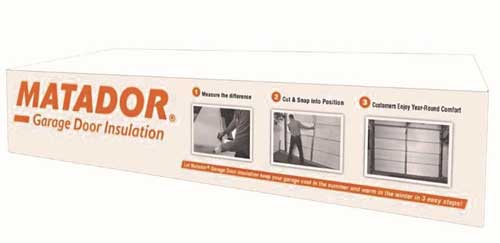
Matador is easily my choice for the best garage door insulation kit, and it’s the one I have in my own garage. You can see how I installed the Matador garage door insulation kit here.
It’s made of a thick polystyrene foam that fits neatly in between individual door panels of a pan-style garage door.
Pan-style garage doors have a thin layer of steel and support rails going along the inside of the door.
The Matador kit should still fit even if you don’t have a pan-style garage door. I’ve got a “sandwich style” garage door, which is thicker. I was able to cut the Matador foam panels with a utility knife and use some foam adhesive to get a nice, solid fit.
Overall, I’m thrilled with the Matador kit. In less than an hour, I was able to lower my garage temperature during the day by around 10 degrees.
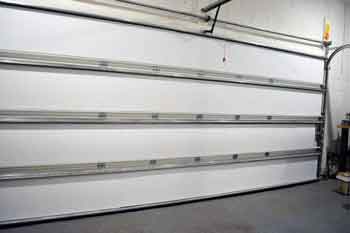

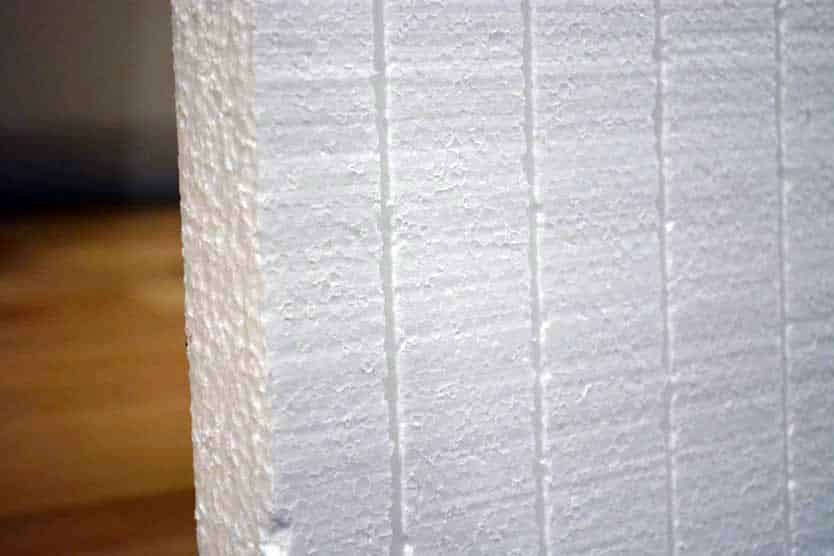
Pros
Cons
- R-Value of 4.8
- Polystyrene laminate panels for durability and soundproofing your garage
- Snap-in installation for many garage door types
- Large garage doors need two kits
- May need to adjust the torsion spring because of the additional weight
Owens Corning
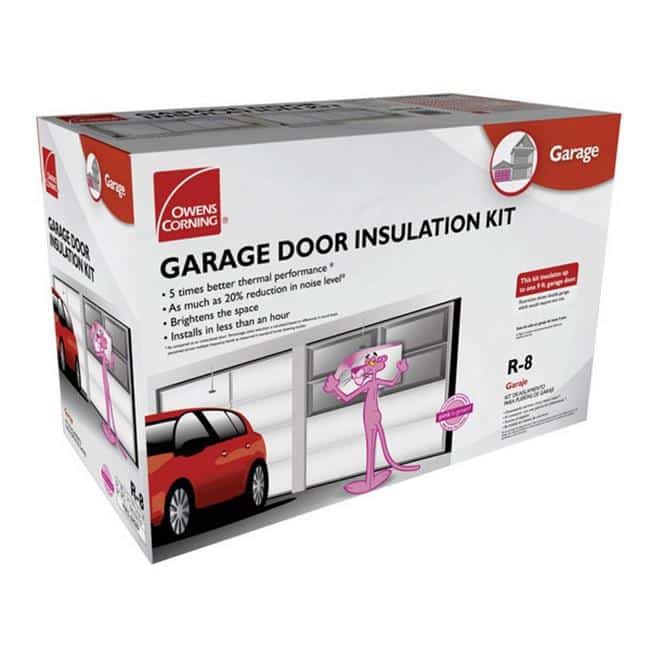
The Owens Corning garage door insulation kit uses actual fiberglass insulation, giving it the highest R-value I’ve found!
The fiberglass panels are incredibly dent resistant. So if you’ve got an environment inside your garage where things can bump into your garage door, this adds an extra layer of protection.
I was always the kid who shot hockey pucks and tennis balls against the garage door, so my parents could have used this when I was growing up.
In addition to having the best R-value for any garage door insulation kit that I’ve found, the fiberglass panels are also really noise resistant. Owens Corning estimates that it could reduce noise by up to 20% over an un-insulated door.
The panels conform to the door itself, so it will only work with doors with a frame inside.
While that’s common in pan-style doors, it’s not common in other door types. So this may not be the right solution, depending on what kind of garage door you have.
Since the insulation snaps onto the door with plastic clips, many homeowners say they need to use Gorilla Tape or other adhesive to clean up the edges.
Pros
Cons
- R-Value of 8.0
- Up to 20% noise reduction
- Only need standard tools to install
- Only works on pan-style doors
- Many users recommend Gorilla Tape to seal the edges
Reach Barrier 3009

The final entry on this list of the best garage door insulation kits is the Reach Barrier 3009. Unlike the Matador and Owens Corning insulation kits, the Reach Barrier kit is a radiant barrier.
As such, it has no R-value, but that doesn’t mean that it’s not effective!
Unlike standard insulation, a radiant barrier works by reflecting the heat (or cold) back to its source.
In a cold climate, the best insulation is a combination of fiberglass or foam panels and a radiant barrier. The foam panels will absorb the cold from the outside air, and the radiant barrier will reflect the heat from your garage back in on itself to help keep you warmer.
The Reach Barrier insulation kit does just that. The reflective metallic sides sandwich a bubble-wrap type of inner layer that helps reduce noise and provide a little extra durability.
Installation is easy, with double-sided adhesive tape. Simply measure and cut to fit your door.
I look at the Reach Barrier (or any radiant barrier insulation) as a “finishing touch” to insulating your garage. It works best in conjunction with another type of insulation or to reflect the heat from a garage heater back into your garage, so it doesn’t escape through the door.
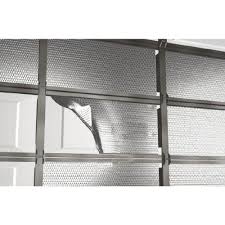


Pros
Cons
- Cheapest insulation solution
- Very lightweight
- Works best in conjunction with other insulation
FAQ
How Much Will it Cost to Insulate My Garage Door?
A brand new insulated garage door will cost between $2,000 – $3,000 by the time you get it installed. By contrast, adding a garage door insulation kit will only cost around $200 for a kit, or about $50, and an afternoon’s work if you go DIY.
To me, the choice is clear. Unless you’re already in the market for a brand new garage door, go for one of the garage door insulation kits (or the DIY version).
Adding it to your existing door may do enough to make your garage more comfortable during the cold winter or hot summer months.
If it doesn’t work as well as you wanted, you can still buy a new garage door down the road. However, you’ve bought yourself a little extra time to find a good deal.
Are There Types of Garage Insulation That Work Better in Warm vs. Cold Climates?
Yes, some types of garage doors and/or insulation work best in hot and cold climates respectively.
If you are trying to keep hot air out and cold air in, a convex foam board with reflective foil is a good option.
Avoid metal doors if you live in a northern climate and want to keep the cold out and warm in. Metal doors are great heat conductors and will steal the heat you have inside and pull it outside.
Instead, your best option could be thermal insulation on a wooden door. You can also install foil sheets on your garage windows to pull heat into your garage.
It’s essential to seal all those cracks and crevices in and around your garage with weather-resistant stripping and add thermal insulation to your garage door itself.
Is There Any Reason to Avoid Garage Insulation?
After reading all this, you’re probably wondering if there’s any reason NOT to insulate your garage door.
In short, yes, there are a few things to consider. You should always think about how the added weight insulation will affect your garage door.
This is no issue for some garage doors, but for others, it can cause significant problems. If your garage has little margin for error in terms of the weight it can handle, adding the weight of insulation can eventually cause the springs to break.
In this case, or if your garage door is older and wearing out, you might be better off purchasing a new one that is better insulated from the start.
However, don’t misunderstand. I am all for insulating your garage door.
When it’s done right and the garage door still functions properly, it shouldn’t cause any issues. If you aren’t sure your door can take the added insulation, do a test run by installing insulation in just one area of the door.
Watch for signs of issues. If you don’t see any, you can likely add insulation to the rest of the door without any problems.


